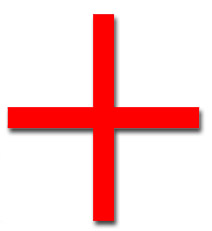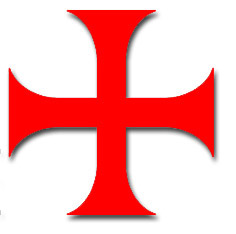 Anyone familiar with the history of Christianity knows that the symbol of the cross has been used in a variety of different ways. Even prior to the time of Crusades there were stories about crosses miraculously showing up on the garments of particularly worthy individuals. There could have been nothing more suitable for crusading armies than to implement crosses as a visual distinction. Abbot Guibert in his History of Jerusalem (1.5) says that Pope Urban II instituted this sign both as an indicator of military distinction and a symbol that would help Christian knights fight with greater valor for God’s cause. The abbot clarifies that the pope ordered the figure of the cross to be cut out of any material (ex cujuslibet materia) and sown onto tunics and cloaks of the members of the expedition.
Anyone familiar with the history of Christianity knows that the symbol of the cross has been used in a variety of different ways. Even prior to the time of Crusades there were stories about crosses miraculously showing up on the garments of particularly worthy individuals. There could have been nothing more suitable for crusading armies than to implement crosses as a visual distinction. Abbot Guibert in his History of Jerusalem (1.5) says that Pope Urban II instituted this sign both as an indicator of military distinction and a symbol that would help Christian knights fight with greater valor for God’s cause. The abbot clarifies that the pope ordered the figure of the cross to be cut out of any material (ex cujuslibet materia) and sown onto tunics and cloaks of the members of the expedition.
Fulcher of Chartres wrote: “O, how fitting and how pleasing it was for us all to see those crosses, stitched in silk or in gold, or made out of any kind of material, which the Pilgrims, following the order of the Pope, fashioned on their shoulders after pledging to set out on this march”.
It is quite evident that there was no specific color or design required of the Crusaders. If any of the original nine members of the Knights Templar Order came to Palestine during the First crusade they would have worn crosses on their garments, but there is nothing to be said about how exactly those crosses looked.
In 1128 Pope Honorius II granted the Knights Templar the right to use white cloaks for distinction and as a symbol of innocence, but without any crosses (“absque aliqua cruce”, says Jacques de Vitry). Only Eugene III (1145-1153) instituted that the Templars should wear red crosses as a sign of martyrdom. With time, this symbol took on another meaning: the red cross became synonymous wit the order itself. It is known that the Knights Templar were very proud of their organization and its uniform (click here for the proof).
It would seem that the specific shape of the early Templar cross was not that crucial (sorry for the pun). Considering the Knights Templar’s humility and their desire to avoid ostentation, a simple cross of two equal intersecting beams (i.e. Greek cross) would have been the most likely to be used at the time. Even a cross with a longer vertical line (Latin cross )requires additional measuring in order “to make it look good”, right?

I believe that only later the cross that is typically seen as the Templar cross (cross pattee) became widely used by the Knights:

The Maltese cross is visually very similar to the splayed cross of the Knights Templar. It is possible that the Templars did not at all feel that this design is all that different. (By the way, he eight points of the Maltese cross have their own special significance as the eight beatitudes of Christianity proclaimed by Christ in the Sermon on the Mount – Mathew 5-7). It is important to remember, however, that the Maltese cross, the way we are used to seeing it, was firmly established as the Knights Hospitaller symbol only in the 16th century, although prior use of similar crosses is well documented.

The main reason why it is advisable for modern Templar enthusiasts, writers etc. to use the second design (i.e. the Knights Templar cross proper, the cross pattee) is that the Maltese cross is too recognizable and has a history as a distinct symbol of the Knights Hospitaller, the order which still exists today under a different name. The Greek cross is also perfectly fine, especially for earlier periods of the Knights Templar history. It is more important to use (if possible) color red, which symbolizes the idea of martyrdom. I firmly believe that if you met a Knight Templar sometime in the 13th century you would have recognized him by the color of the cross, rather than by its shape.
See also:
Free images of the Knights Templar cross, including PNGs with transparent background.
Was the Cross of Lorraine ever a symbol of the Knights Templar? …That’s the traditional cross with double cross-arms. Thanks!
Not sure if the Cross of Lorraine can be called a Knights Templar symbol per se, but it was indeed used by the Templars, as well as the Hospitallers. Bernard the Treasurer indicates that the early members of the Order wore this cross, which indicated their loyalty to the Patriarch of Jerusalem. However, that loyalty was short-lived, at least in the technical sense.
Excellent posting. Very helpful and informative. Love the Web site.
What are your thoughts that Freemasons may be in some sense the descendants or inheritors of the Templars?
GK
God Bless
Godfrey,
Yes, I have heard of this claim of the Freemasons being descendents of the Knights Templar. There would have to be a lineage established that should be unbroken, some writings, individuals who could show an ancestry to one of the Knights Templar (preferably to one of the leading figures of the Knights Templar), possessing important artifacts of the Templars in their family heirlooms, etc.
Since the middle of the 19th century, Masonic historians have sought the origins of the movement in a series of similar documents known as the Old Charges, dating from the Regius Poem in about 1425 [Andrew Prescott, “The Old Charges Revisited”, from Transactions of the Lodge of Research No. 2429 (Leicester), 2006, Pietre-Stones Masonic Papers] to the beginning of the 18th century. Alluding to the membership of a lodge of operative masons, they relate a mythologised history of the craft, the duties of its grades, and the manner in which oaths of fidelity are to be taken on joining. [A. F. A. Woodford, preface to William James Hughan, The Old Charges of British Freemasons, London, 1872] The fifteenth century also sees the first evidence of ceremonial regalia [John Yarker (1909) The Arcane Schools. Manchester. pp. 341–342] There is no clear mechanism by which these local trade organizations became today’s Masonic lodges, but the earliest rituals and passwords known, from operative lodges around the turn of the 17th-18th centuries, show continuity with the rituals developed in the later 18th century by accepted or speculative Masons, as those members who did not practice the physical craft came to be known.[Robert L.D. Cooper, Cracking the Freemason’s Code, Rider 2006, Chapter 4, p 53] The minutes of the Lodge of Edinburgh (Mary’s Chapel) No. 1 in Scotland show a continuity from an operative lodge in 1598 to a modern speculative lodge.[David Murray Lyon, History of the Lodge of Edinburgh (Mary’s Chapel) No 1, Blackwood 1873, Preface] It is reputed to be the oldest Masonic lodge in the world. [Stevenson, David (1988). The Origins of Freemasonry. Cambridge University Press. pp. 38–44]
In these matters a good measure of skepticism is called for. I would say, possible, yes, but probable, no.
Very shortly this web page will be famous amid all blogging viewers,
due to it’s nice articles or reviews
I have just recieved my cloak from knights templar shop the cross is a wine colour is this right thought it was always red ??? Thanks
In the Middle Ages it was very difficult to maintain uniformity in colors. Anything in the red spectrum would have been acceptable, I’m pretty sure.
You have a fine website. I too, was installed, becoming a KT some years ago. Although, I have been out of work, I could not keep up with the dues. I still consider myself as a KT and always will. It’s in my blood, literally.
Thanks,
A FREE KNIGHT
were the kights templers des?endents of Christ?
No, they were not.
What do you think about the association of the Knights Templar with the Jerusalem Cross?
Need more knowledge and want to be KT member,How?
Thank you
Joe Abrams
Bangkok
My son is really interested in the knights templar. How could he go about being a member.
I have no idea how old this article is, I stumbled across it looking for information on the templar’s clothing. Thank you for the information as it has helped my understanding of the cross shapes I see.
Wanted to also toss out, as a Freemason myself, that no… there is no connection, nor has the Grand Lodge (England and beyond) ever claimed such. We have a “degree” in our York Rite that is named after the Knights Templar, but only in name and (my assumption) honor. There are a million places to read more, I won’t link them, but a summary statement “An Order emphasizing the lessons of self-sacrifice and reverence. It is meant to rekindle the spirit of the medieval Knights Templar devotion and self-sacrifice to Christianity.”
Lars